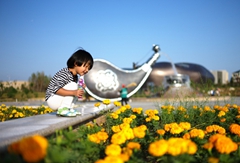Ordos, the great metamorphosis of a ‘ghost town’
Updated: 2019-08-23  Print
Print 



An aerial photo of Kangbashi district in Ordos, North China’s Inner Mongolia autonomous region. [Photo/people.com.cn]
Kangbashi district in Ordos, North China’s Inner Mongolia autonomous region, a place once described as a "ghost town" by foreign media outlets due to its desolate, has finally succeeded after years of efforts.
In 2003, Dongsheng district, where the Ordos municipal government used to be located, had a built-up area of 27 square kilometers and a population of 230,000. Less than 40 square kilometers of land in the area was capable of being developed, and there were only 17 square meters of road and 6 square meters of green area per capita, lower than the national average. In order to alleviate structural contradictions in urban development, construction on Kangbashi began in May 2004.
In the initial stages of development, Ordos relied on its rich resources and promoted the rapid development of the industrial economy through resource conversion. Kangbashi was built to meet the needs of industrial development in the main urban area of Ordos.
But development is no longer reliant on resource excavation and the district has upgraded its industrial structure and transformed new and old kinetic energy. Kangbashi has irrigated over 15 million square meters of green fields by relying on its water-saving system. By the end of 2018, 7.48 million square meters of residential buildings had been built. There are now only 561 unsold houses in the district, and the permanent population has reached 150,000.
The old “ghost town” with substandard facilities, a small population, and little green space now has better infrastructure and a booming economy.
Kangbashi now attracts large numbers of tourists, receiving 2.857 million visitors in 2018, with tourism revenue accounting for 16 percent of its GDP. The development of tourism has created a large number of jobs in the district. There are currently 48 hotels in Kangbashi with a total of 3,453 rooms, and the occupancy rate during tourist season is nearly 100 percent.
The story of Kangbashi can be seen as a microcosm for China's economic transition to high-quality development.

The Ordos museum and library, located in Kangbashi district. [Photo/people.com.cn]





 Ordos Impression
Ordos Impression Ordos WeChat
Ordos WeChat Ordos Reported
Ordos Reported


